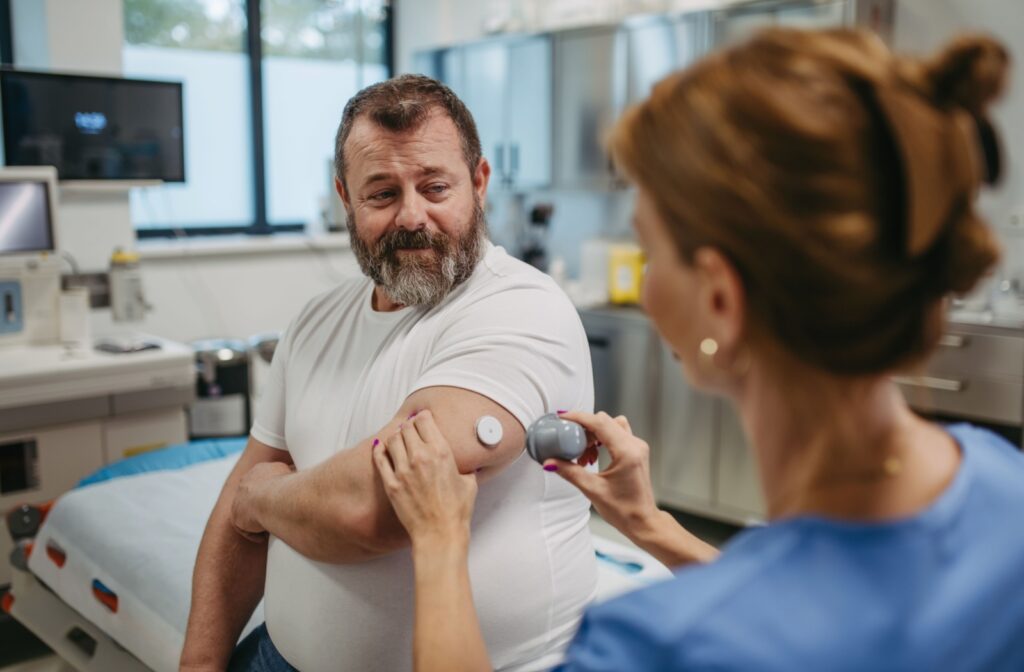Diabetes is a complex condition that can have significant impacts on various parts of the body, including your eyes. Surprisingly, eye exams are not just for correcting vision—they can also be critical in detecting diabetes. In particular, diabetic retinopathy causes damage to blood vessels in the retina, which is caused by high blood sugar, which can be seen in an eye exam.
What Is a Diabetic Eye Exam?
A diabetic eye exam is a specialized evaluation of the eyes to identify signs of diabetes or diabetes-related complications, such as damage to blood vessels in the retina. Unlike general vision screenings, this examination assesses the retina’s and eye structures’ health.
Eye care professionals use advanced imaging technologies to assess and monitor changes caused by high blood sugar levels. Here are two key diagnostic technologies commonly used during these exams:
Optos Optomap Retinal Imaging
Optos Optomap retinal imaging is a state-of-the-art technology that allows eye care professionals to capture ultra-wide-field retina images without dilating your eye. This device provides a detailed view of the back of the eye, helping to identify early signs of diabetes, such as restricted blood flow, swelling, or the formation of abnormal blood vessels.
It is noninvasive, quick, and provides a comprehensive snapshot of retinal health. From here, our optometrists can analyze the images and provide strategies to manage your eye health.
Optical Coherence Tomography (OCT)
OCT is another important diagnostic tool. It uses light waves to create cross-sectional retina images, allowing healthcare providers to analyze each layer in incredible detail. This technology is especially effective in detecting retinal swelling, which is often linked to diabetic macular edema, a condition that can impair vision if left untreated.
Optos and OCT technologies allow for the early diagnosis and monitoring of diabetes-related eye conditions, ensuring timely intervention and personalized care.
LKC RETeval – ERG (Electroretinography)
LKC RETeval is a portable electroretinography (ERG) test that measures the retina’s electrical response to light. What sets this device apart is its ability to calculate a Diabetic Retinopathy (DR) score, which predicts the likelihood of developing retinopathy in the future. By identifying potential risk early, healthcare professionals can implement preventive strategies and tailor treatments to reduce the progression of retinal damage.
This noninvasive and efficient test is a valuable tool in proactive diabetic care. It empowers both patients and providers to take informed steps to preserve vision.
How Does Diabetes Affect Your Eyes?
Diabetes occurs when the body doesn’t produce enough insulin or cannot effectively use the insulin it makes. Over time, elevated blood sugar levels can damage small blood vessels, including those in the eyes.
The retina, located at the back of the eye, is particularly vulnerable to damage. It relies on a network of tiny blood vessels to function correctly. When diabetes leads to impaired circulation, it can result in a range of vision-threatening conditions.
Here’s how diabetes might affect your eye health:
- Diabetic Retinopathy: Damage to the retinal blood vessels can result in vision loss if untreated.
- Macular Edema: Swelling of the macula (central part of your retina), leading to blurred or distorted vision.
- Cataracts: Clouding of the lens, which becomes more common in individuals with diabetes.
- Glaucoma: Increased intraocular pressure caused by fluid buildup can damage the optic nerve.
While these conditions may initially present few or no symptoms, they can lead to serious complications, including permanent vision loss, if left undetected.
Diabetic Retinopathy: The Silent Symptom
Diabetic retinopathy is one of the most common—and silent—complications of diabetes. It often presents no noticeable symptoms early on, making routine eye exams crucial for detecting it before irreversible damage occurs.
The condition progresses in stages:
- Mild Non-Proliferative Retinopathy (NPDR): Tiny blood vessels in the retina weaken, causing small bulges or microaneurysms.
- Moderate NPDR: Blood vessels become more extensively damaged, reducing oxygen supply to the retina.
- Severe NPDR: The retina becomes deprived of oxygen, signaling the growth of abnormal new blood vessels as a response.
- Proliferative Diabetic Retinopathy (PDR): Fragile, new blood vessels grow and may leak blood into the eye, causing severe vision complications, including blindness.
Diabetic retinopathy is a condition that thrives in silence, making it critical for diabetics—and even pre-diabetics—to schedule regular, comprehensive eye exams.

Who Should Be Paying Attention?
If you have diabetes, regular eye exams are non-negotiable. But several other groups should carefully monitor their eye health:
- Individuals with a family history of diabetes: If diabetes runs in your family, you should be proactive about your overall health and vision. Even if you don’t experience vision problems, a diabetic eye exam can help catch changes early.
- Pregnant people with gestational diabetes: Gestational diabetes, which occurs during pregnancy, increases the risk of diabetic retinopathy. Pregnant people diagnosed with this condition should have their eyes checked to ensure no damage to the retina.
- Health-conscious individuals over 40: Your risk of eye-related complications increases with age. Adding a diabetic eye exam to your routine medical care could help avoid potential health issues.
What If I’m Not Diagnosed with Diabetes?
Interestingly, many people first learn about their diabetes through an eye exam. Changes to the blood vessels in the retina are often among the earliest signs that something is wrong. If an eye care professional notices these changes, they may recommend that you see your primary care doctor or an endocrinologist for further evaluation.
An eye exam might not provide a definitive diagnosis of diabetes, but it can help you get the necessary care.
How Often Should I Have an Eye Exam?
If you have been diagnosed with diabetes, the American Diabetes Association recommends annual comprehensive diabetic eye exams. However, depending on the severity of your diabetes or any complications, your eye care provider may advise exams more frequently.
For individuals who have not been diagnosed with diabetes but are at risk of developing it (such as pre-diabetics or individuals with a strong family history), a comprehensive eye exam every year or two is a good practice.
Protect Your Vision with Regular Diabetic Eye Exams
Your eyes are windows to the world and to your health. Diabetic eye exams offer a dual benefit: They allow you to monitor your vision while gaining insights into your overall well-being. Regular exams can detect early signs of diabetes, prevent serious complications, and ensure timely treatment for any issues. At River City Vision Center, we believe managing your eye health is essential to your overall health care routine. Contact us today to learn how our team can support you in managing your diabetes





